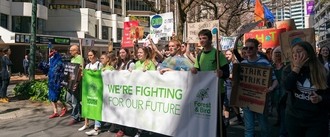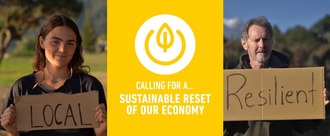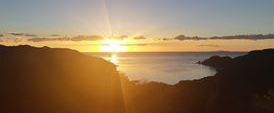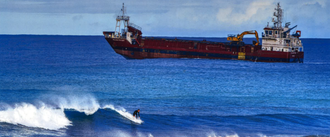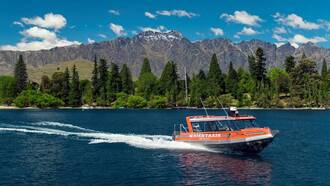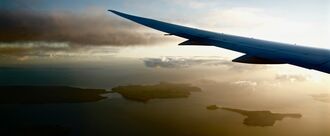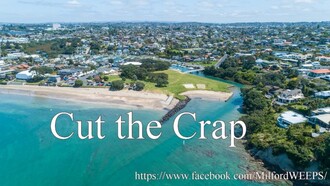-
Put nature at the heart of the COVID-19 recoveryNature is on the verge of collapse. New Zealand has 4000 species in trouble, polluted waterways and a damaged marine environment; only transformative economic and policy decisions can restore and sustain our planet and our people. The rebuilding of our society after the impacts of COVID-19 provides us with a chance to restore our natural environment for both current and future generations.416 of 500 SignaturesCreated by Forest & Bird Youth

-
School Strike 4 Climate NZ & 4 Tha Kulture Open Letter Calls For Covid Green ResponseAs the youth of Aotearoa, it is important that the decision and projects that we put forward work around securing our generation a safe future. The children of New Zealand will be paying off the debt collected from the stimulus project. We demand that you, as the leaders of today, ensure us a safe future924 of 1,000 SignaturesCreated by School Strike 4 Climate NZ

-
COVID19: Re-set Our Economy SustainablySustainability has been at the forefront of New Zealand’s news, our elections, and spurred hundreds of thousands of kiwis to peacefully protest. Despite this, and the extremely urgent message science is giving us, there has been a distinct lack of action. COVID19, in an unexpected and undesirable way, has given us the opportunity to re-set. Our new normal does not mean going back to the ways we know are broken. Our new normal means re-setting how we live, work, produce and govern in a way that regenerates. To start to heal what we have done while living outside the biophysical limits of the Earth. This gives us, future generations and other species a fair chance. It will help prevent, and be more resilient to, future crises. This disruption is a time to re-think systems and unite business, government and NGO's. Unlike ever before, we have the means and motivation to collaboratively and fairly transition our economy for a sustainable future. It's clear that if this opportunity is not navigated properly, with courageous and informed decision making, the future we are borrowing from our Mokopuna (Grandchildren) will not be a bright one. The decisions now will make our bed for decades to come and they must be the right ones. Our Leaders have a moral, and legal (Paris Agreement), responsibility to create a strong, resilient, local economy that regenerates Papatūānuku (Mother Earth) and fosters actualised human wellbeing.3,022 of 4,000 SignaturesCreated by Shay Lawrence - CaliWoods

-
Invest in a healthy and flourishing planet for our future - a covid responseThe Government has shown a commitment to COVID-19 recovery and have indicated that it will make significant investment in infrastructure. To protect the planet and protect our future, it is important that this investment does not lock us further into the high-emission pathway we are on, as such investments will accelerate the climate and ecological breakdown. The Government has tasked the Infrastructure Industry Reference Group to present it with projects that are ready to start within six months. The projects that are selected will be pivotal in determining our future! We are afraid for our ecosystems, animals and people that projects which lock us into a high-emission and ecologically unsustainable pathway will be selected. To prevent this, and to achieve a future that is connected to a healthy and flourishing planet, we need to urge the Government to invest in transformation climate change projects. Further examples of possible projects include restoring our ecosystems, enhancing walking and cycling routes, and green tech innovations. Please sign this petition if you want to call on Government to invest in a healthy and flourishing planet for our future. Government seeks infrastructure projects https://www.beehive.govt.nz/release/government-seeks-infrastructure-projects199 of 200 SignaturesCreated by Hannah Riley
-
Ban marine dumping of dredged materialAotea Great Barrier Island is surrounded on all sides by the pristine waters of the Hauraki gulf and the Pacific ocean. For a decade local residents and iwi have challenged a plan by a private company Coastal Resources Limited that wanted to unload 140 barge-loads annually of contaminated sludge dredged from the sea floor off the coast of their island for the next 35 years. Sadly the traditional hāpuka grounds have already been destroyed by previous dumping of sediment. Allowing massive marine sludge dumping is unacceptable. Protect Aotea went to court to appeal the decision to give the consent - and we won! In December 2019, our High Court appeal against the granting of consent by the Environmental Protection Agency (EPA) to Coastal Resources Limited (CRL) to dump 250,000 cubic metres of marine sludge off the coast of Aotea Great Barrier Island was successful - effectively quashing the decision of the EPA. Kelly Klink, of Protect Aotea, says, “While we are relieved to have won the court case to prevent CRL’s appalling dumping of toxic waste sludge into our pristine marine environment, we are deeply concerned and unhappy about the extremely destructive ongoing practice of waste dumping within the RMA and Exclusive Economic Zone.” “We are determined to ensure that new, environmentally sound policies are urgently put in place to ensure that less damaging alternatives to marine dumping are deployed – such as proper disposal of waste on land or engaging the process of mudcrete.” “We are concerned that there is currently no meaningful consideration of alternative methods of disposal of the dredged material, rather the waste is dumped directly into our precious moana. This cannot be allowed to continue.” We are uniting again to stop the marine dumping of dredged waste happening to other communities in Aotearoa. We call on the Government to change the law that will ban this harmful method of dumping waste and enforce alternative methods. All policy and law-making should acknowledge a tikanga Māori approach to achieving well being for our moana. Such a policy will enable local hapū and iwi to properly manage and care for the taonga species that depend on a healthy marine environment to survive; which is intrinsic to the Government’s Te Tiriti o Waitangi obligation to Māori to ensure traditional fishing grounds are protected for generations to come. We call on the New Zealand government to respect the mana and will of the tangata whenua and help protect the health and wellbeing of our oceans through our laws. With legal protection tangata whenua and the community will reconnect with the moana and implement a tikanga Māori approach to achieving well being for our still-pristine coastlines. Add your name to ban marine dumping of dredged material in any part of beautiful Aotearoa. *** Great Barrier residents win reprieve over dredged waste increase, Dec 2019 https://www.nzherald.co.nz/nz/news/article.cfm?c_id=1&objectid=12290755 More than 200 people marched up Auckland's Queen Street, June 2019 https://www.facebook.com/watch/?v=1356765834504795 March to Protect Aotea, Great Barrier Island, June 2019 http://www.ngatiwai.iwi.nz/our-stories/march-to-protect-aotea-great-barrier-island Large scale marine dumping near Great Barrier concerning, July 2019 https://www.miragenews.com/large-scale-marine-dumping-near-great-barrier-concerning414 of 500 SignaturesCreated by Kelly Klink
-
Save our Sands - stop sand mining at Mangawhai Pakiri BeachesPakiri beach, two hours north of Auckland, is a natural treasure. People come to enjoy its glistening white sand, miraculous dunes, precious ecosystems and the rare species that make it their home. It should be protected as a taonga for generations to come. Yet for decades Pakiri has been mined for its white sand. It’s the site of the largest single nearshore sand mining activity in the developed world. Sand mining involves extracting sand from the sea floor. Sand mining literally sucks the life out of our sea bed floor, leaving 16km of suspended sediment plumes in its place. Yet, just as the benthic sea bed community is being appreciated as ever more important. Dredging releases carbon stores ("blue carbon"); it is out of step with these times, just as seabed trawling is being phased out in many places. With less sand making it onshore, it also causes erosion to dunes and foreshores. This sand extraction is causing erosion, destroying shellfish beds, stealing safe nesting spots from endangered birds and ruining surf breaks. Pakiri Beach is home to the Fairy Tern, New Zealand's rarest bird. There is a finite supply of Pakiri Beach’s sand and once it’s gone, it’s gone forever. There are other non-erosionary sources of sand, so it’s not necessary to mine Pakiri Beach. The dredging is by NZ’s oldest marine reserve, with two new Auckland Reserves are at either end of the beach. Can there be a less appropriate place for dredging? We now live in an era of environmental awareness. Single use plastics bags have been banned, we all now think about and mitigate our environmental impact in everything we do. So why in this environmental era, in Green NZ of all places, allow permits to mine sand, in an intensive, primitive way from precious beaches like Pakiri, when there are alternate sustainable sources and so much future climate volatility and uncertainty looms? As COP26 is underway and the world seeks to changes its ways and work with the environment and find new sustainable paradigms, the McCallum’s approach is the following. They specifically commissioned a new dredging vessel which has been delivered and is being used, of double the holding capacity of their other vessels. Now they wish to expand their operations and the volumes as taken from new consents of higher volumes and a 35 year term. The contradiction in terms could not be any starker. This is what we are up against. Save our Sands being Friends of Pakiri Beach, Te Whanau O Pakiri, Tangata Whenua, locals and concerned New Zealanders, with the support of GreenPeace, are taking a stand and we need your help! Join us in saying 'no' to sand mining. Sign and share the page and please submit your opposition to Auckland Council and make a difference. Damon, Nick and the FOPB team. * We are still awaiting a decision on the first consent. It has been delayed because we alone were able to reveal deep seabed trenches caused by the dredging, which hadn’t been revealed by the dredger’s. This has caused the resource consent hearing committee to stipulate further investigation. We are making a difference.6,143 of 7,000 SignaturesCreated by Friends Of Pakiri Beach
-
Keep the Wakatipu Ferry on the waterWe have a very effective commercial ferry service operation on Lake Wakatipu which is well patronised by locals and visitors alike. As a resident of Kelvin Peninsula, I regularly use the service when heading to the centre of Queenstown. However it cannot continue without a similar subsidy to that which the $2 buses get. The service is scheduled to be shut down at the end of February 2020 to the dismay of the local users: https://www.odt.co.nz/regions/queenstown/lake-ferry-service-wind. Once shut down it will be difficult to resume operation. The Queenstown Lakes Region is facing increasing road congestion caused by exponential growth in local and visitor traffic. Queenstown Lakes District Council, the NZ Transport Agency and the Otago Regional Council have done a great job in moving residents to bus services with a subsidised service which as well as getting cars off the roads, has the added benefit of climate change mitigation. Water transport is potentially one of the most efficient and climate friendly means of transport for the Wakatipu basin. No roading infrastructure required and currently existing jetties are utilised. Plus the ferry is a really beautiful way to travel. As with all public transport, the ferry service must be reliable, frequent and reasonably priced to encourage use. We have a local commercial operator providing an excellent service for a year now but it is not cost effective for them. Queenstown Lakes District Council, the NZ Transport Agency and the Otago Regional Council recognise this but are slow in implementing a long term plan. Allowing an existing ferry service to fail through bureaucratic inertia would do the community a huge disservice and set back the momentum for positive change. As Chair of the Kelvin Peninsula Community Association, I urge the ORC to respond swiftly to this public transport need.1,926 of 2,000 SignaturesCreated by David Mayhew
-
Fight for Te Rotorua nui a Kahumatamomoe (Lake Rotorua)* Lake Rotorua is a taonga as are all the waterways connected to it #TAONGAnotTOILET * Many communities and families still source food from the lake * Serious contaminants will still exist in the treated sewage when it is discharged into the stream that flows into the lake * No lake in Rotorua will be safe if this discharge happens * We must leave a legacy of clean water and air for our mokopuna, Rotorua and Aotearoa * Getting the lake the same legal recognition as a person, will make it more difficult for groups to purposely pollute and disrespect it Te Arawa Lakes Trust says no to treated wastewater in Lake Rotorua, NZ Herald, 4 Dec 2018 https://www.nzherald.co.nz/nz/news/article.cfm?c_id=1&objectid=121703314,723 of 5,000 SignaturesCreated by Renee Kiriona
-
Aviation Eco-Tax to offset climate impact of flyingAlthough aviation only accounts for about four percent of all warming activity, it is growing at a rate of five percent each year. This means it is on track to double in 15 years as people in poorer countries become accustomed to the kind of lifestyles westerners have been enjoying for decades. People living in New Zealand are among the worst offenders for greenhouse gas emissions from aviation. There are no currently-viable technologies that can enable people to fly without adversely affecting the climate. In New Zealand the cost of taking a bus or train is very high relative to flying. Flying is so cheap there is no incentive to travel by means which emit less CO2. In Sweden the amount added is very moderate, ranging from $10 to around $60. If you can afford to buy a ticket, you can also afford to pay the tax. Despite the fact that the amount is so small, the effect in Sweden has been very positive, with a decline in flight passengers and rapid growth in train ridership. There has been a significant shift in attitudes and these are outcomes we need in New Zealand as well. Each of you holds a portfolio which will either be impacted by climate de-stabilisation, or is directly linked to taxing aviation. Please bring in an Aviation Tax now.129 of 200 SignaturesCreated by Anguli Julie
-
Fix Wairau Estuary & Milford BeachNorth Shore beaches are the pride of Auckland and are of world renown. Wairau Estuary and Milford Beach are a regional resource. Large numbers of visitors from South and West Auckland enjoy them throughout summer. Yet Wairau Estuary is one of the most heavily contaminated waterways in Auckland. The contamination includes silt (that chokes seafloor life), human faecal contamination, heavy metals and hydrocarbons. Wairau Outlet has a permanent no swim warning. The only one north of the Harbour Bridge. There is human sewage in the Wairau Estuary. This contaminates Milford Beach. Heavy metals and hydrocarbons in the Estuary are carried with silt onto Milford and Castor Bay Beaches. High levels of Zinc, Lead, Copper, Cadmium, Chromium and Arsenic are present. Polyaromatic hydrocarbons cause cancer and are found in the sediment of Milford Beach in moderately elevated (amber zone) quantities. There is a total ban on gathering shellfish off the Wairau Outlet, because they contain human faecal matter. Council puts a red no swim advisory on any beach when 2 in every 100 swimmers are likely to get sick. Swimming illness is usually mild; it takes the form of a “cold”, ear infection or sinus infection. Or a “tummy bug”, with diarrhoea or vomiting. Most people view swimming as healthy and mistakenly blame other factors for their illness. Children are at highest risk from swimming, because they play in the shallows where the faecal bugs concentrate. The Wairau Estuary is special to Milford & Castor Bay. There is nothing similar on other North Shore beaches. It should be a jewel in the crown; a place that people & wildlife seek out rather than avoid because it is stinky & toxic. In addition to its own unique features, it can be a connection between Lake Pupuke, Sylvan Park, Milford & Castor Bay Beach. Sign our petition for a cleaner, safer Milford Beach and Wairau Estuary.1,238 of 2,000 SignaturesCreated by Guy Armstrong
-
Save NZ DolphinsMāui dolphins are on the brink of extinction and Hector’s dolphins are heading towards a similar fate if nothing changes. These dolphins are taonga and native to New Zealand, they’re not found anywhere else in the world. The single greatest threat to Māui and Hector’s dolphins is fishing nets. There used to be around 50,000 Hector’s but now, because of destructive fishing methods, not many more than 10,000 remain. For the critically endangered Māui, it’s even worse. In the 1970s there were around 2,000, now there are fewer than 60 left. If we don’t act now we risk losing New Zealand dolphins forever. We need to save them, and we hope you will help us! Whale and Dolphin Conservation (WDC), has been working in New Zealand behind-the-scenes for years gathering evidence and garnering political and public support. Now it’s time for all of us to raise our voices and be heard. Around 110 to 150 New Zealand dolphins die in set nets every year and a similar number in trawls. Set nets are sometimes referred to as ‘walls of death’. They hang in the water, anchored to the sea bed with weights and are stretched across the surface with floats. They are indiscriminate, catching every creature that swims into them. Trawl nets are dragged through the water by boats and, like the set nets, scoop up whatever and whoever is in their path. Right now Hector’s and Māui dolphins are protected from set nets in just 30% of their habitat and from trawl nets in less than 10%. But, here’s the great news – if we band together we can protect them and we could save the species. Are you with us? The New Zealand government is currently working on what’s called a Threat Management Plan for these dolphins – this plan outlines what the government intends to do to look after the dolphins. However the plan is woefully inadequate; the government proposals will allow at least 50 dolphins to die every year in fishing nets. This is unacceptable! See the plan here: https://www.mpi.govt.nz/dmsdocument/34971. We’re urging Prime Minister Jacinda Ardern to remove these dangerous nets from the dolphins’ home. We’re calling for the New Zealand government to transition our country away from destructive fishing methods, and immediately phase out set net and trawl fishing within the dolphins’ habitat, to the 100 metre depth contour, around the whole coast of the country. The government must also consult relevant local iwi about implementing a phase out of trawling and set nets in line with the obligations of Te Tiriti o Waitangi. This is our chance to show the government how much we love these dolphins. They are taonga and deserve to survive and thrive. Sign our petition to send the Prime Minister a message and help us save them! What you can do: - Write to Prime Minister Jacinda Ardern, using the automatic form on our petition page - Like and share our Facebook/Instagram pages https://www.facebook.com/whalesorgnz/ https://www.instagram.com/wdc_nz/ - Post on social media about NZ dolphins and share it with us using the hashtag #SaveNZDolphins https://vimeo.com/38589757010,045 of 15,000 SignaturesCreated by Whale and Dolphin Conservation

-
Support the Lets Get Wellington Riding VisionWe're seeing electric bikes and scooters sales grow at 100% year on year, and we've seen an increase in commute cycling of 25-40% across the city in the last year. They're often the fastest and cheapest ways around the city. We should be doing everything we can to support them. These new vehicles need safe space to operate on the road. The current plans for cycleways were developed before the explosion in these new types of vehicles. As such, it's no longer fit for purpose. We’ve designed the Let's Get Welly Riding Vision for Wellingtonians to take and run with (or ride, as the case may be). We hope you are inspired and join us in making Welly the best place in the world to live!320 of 500 SignaturesCreated by Oliver Bruce

